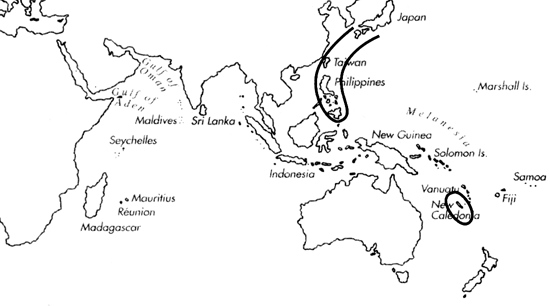Range: Japan to Philippines and in New Caledonia.
Description: Moderately small to medium-sized, moderately solid. Last whorl conical or ventricosely conical, sometimes broadly conical; outline variably convex at adapical third to two-thirds, straight below. Shoulder angulate, rarely outwardly curved. Spire usually low, outline concave to almost straight. Larval shell of 3-3.5 whorls, maximum diameter 0.9-1 mm. First 1-2.5 postnuclear whorls tuberculate. Teleoconch sutural ramps flat or weakly concave, with 1-3 increasing to 5-6 spiral grooves. Last whorl with a few weak spiral ribs or ribs and ribbons at base.
| Shell Morphometry | ||
|---|---|---|
| L | 25-40 mm | |
| RW | 0.13-0.19 g/mm | |
| RD | 0.60-0.71 | |
| PMD | 0.81-0.94 | |
| RSH | 0.07-0.13 | |
Ground colour white, occasionally tinged with yellow to tan in places. Last whorl with a broad brown spiral band on each side of centre and brown axial streaks from base to shoulder ramp. Larval whorls yellow to white. Teleoconch sutural ramps with brown radial streaks. Aperture white, slightly translucent except in large adults.
Periostracum grey, thin, translucent and smooth in juveniles, becoming grey-olive, thicker and opaque during growth, with axial ridges on spire and last whorl and with widely spaced tufted spiral lines from base to shoulder.
Habitat and Habits: In 80-500 m.
Discussion: C. capitanellus is similar to C. capitaneus and C. plinthis; the former species attains much larger size, and its last whorl is less convex in outline, bears spiral rows of coarse and minute brown dots and has a dark brown base. For comparison with C. plinthis, see the DISCUSSION of that species.

C. capitanellus range map
This section contains verbatim reproductions of the accounts of 316 species of Conus from the Indo-Pacific region, from Manual of the Living Conidae, by Röckel, Korn and Kohn (1995). They are reproduced with the kind permission of the present publisher, Conchbooks.
All plates and figures referred to in the text are also in Röckel, Korn & Kohn, 1995. Manual of the Living Conidae Vol. 1: Indo-Pacific Region.
The range maps have been modified so that each species account has it own map, rather than one map that showed the ranges of several species in the original work. This was necessary because each species account is on a separate page on the website and not confined to the order of accounts in the book.